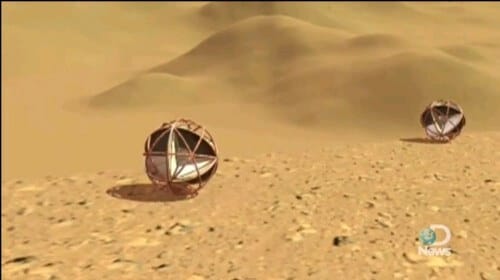An innovative mobility vehicle that rolls in the wind like rolling grass, was developed in collaboration with NASA for the purposes of mobility and research on Mars.

Tumbleweed is a collection of dry plants, cut off from the root, that roll in the wind. It is usually a whole plant, whose tangled dry branches form a massive spherical structure that is rolled by the wind and thus spreads its seeds.
This unique seed dispersal mechanism, which excels in dispersal over long distances using wind energy, served as a source of inspiration for an innovative and ground-breaking form of mobility, which would be suitable for the distant regions of Mars.
As far as is known, Mars is covered with rocks and sand dunes. These terrains are a challenge for a wheeled vehicle. One of the wheels of the vehicle "Opportunity" got stuck in the sand in 2005, and remained stuck on Mars for over a month, until a way was found to get it out.
A vehicle without wheels has an advantage in moving over difficult and inaccessible terrain such as valleys. In addition, because of the different gravity conditions on Mars (about 1/3 of the gravity on Earth) even a slight movement will allow a spherical body without wheels to roll.
Researchers from the Jet Propulsion Laboratory (JPL) at the California Institute of Technology, in collaboration with NASA, have proposed an innovative and interesting concept of a lightweight, wheelless spherical vehicle, equipped with scientific research equipment, and powered by the "breeze" on Mars instead of an internal battery. Utilization of resources Natural saves costs, so that theoretically an entire fleet of such vehicles can be deployed for the price of one motorized wheeled vehicle. The vehicle contains tools that enable research tasks to be carried out, such as collecting samples and analyzing them. Using a three-dimensional dynamic model and computer simulations, it was demonstrated how it is possible to explore Mars using such a vehicle .
In the video attached to this link, you can watch a demonstration of the rolling vehicle.

Already in 2003, a prototype of this vehicle was tested on a long-distance drive in Greenland. Equipped with instruments and satellite communications, the vehicle traveled more than 80 miles in less than two days, sending data every half hour to a ground station at JPL. Despite the long time that has passed since this field experiment, the project is still in the development stages during which similar models were tested using computer simulations. Even in our districts such a vehicle can be used, when a dedicated cargo can be used to search for water sources, under the ice at the poles or in arid desert areas.
Until the first man moves on Mars in a spherical vehicle rolling in the wind, we will be satisfied with the spectacle of the bushes rolling in our districts.
